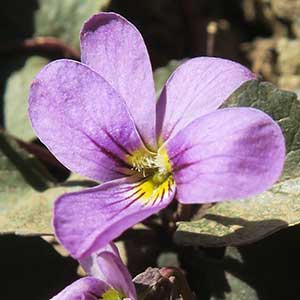Viola flettii
Viola canina
Flett's violet, Olympic violet, rock violet
dog violet, heath dog-violet
1–3, ascending to erect, mostly glabrous, on caudex from fleshy rhizome.
1–5, ascending to erect, glabrous, on caudex from subligneous rhizome.
basal and cauline;
basal: 1–3;
stipules linear-lanceolate, margins entire or with glandular processes, apex acuminate;
petiole 1.5–9.7 cm, mostly glabrous;
blade purple-tinted and –veined, broadly reniform to ovate, 0.9–2.4 × 1.2–4 cm, base cordate, margins finely crenate-serrate, eciliate, apex acute to obtuse, surfaces glabrous or sparsely pubescent along veins adaxially;
cauline similar to basal except: stipules ovate to lanceolate, margins entire or shallowly laciniate;
petiole 0.7–5.9 cm, usually glabrous;
blade 0.8–2.1 × 1.2–3.1 cm.
cauline;
stipules linear to lanceolate, margins ± lacerate to subentire, points often gland-tipped, apex acute;
petiole 0.3–2.5 cm, glabrous;
blade ovate to narrowly ovate, 1.2–5.2 × 1–2.7 cm, base cordate or deeply cordate to truncate, margins crenate, eciliate, apex acute to obtuse, abaxial surface glabrous or sparsely pubescent on veins, adaxial surface glabrous or sparsely pubescent.
1.8–7.1 cm, usually glabrous.
1–10 cm, glabrous or sparsely puberulent.
sepals lanceolate, margins eciliate, auricles 0.5–1.5 mm;
petals soft reddish violet on both surfaces, all with yellow area basally, lower 3 dark violet-veined, lateral 2 bearded, lowest with white around yellow area, 10–15 mm, spur yellow, gibbous, 0.5–2 mm;
style head bearded; cleistogamous flowers axillary.
sepals lanceolate, margins eciliate, auricles 2–3 mm;
petals usually blue- to gray-violet on both surfaces, rarely white, white basally, lower 3 dark violet-veined, lateral 2 bearded, lowest 15–25 mm, spur light yellow to light green or white, gibbous to usually elongated, 3–5 mm;
style head beardless; cleistogamous flowers axillary.
± spherical, 5–9 mm, glabrous.
ovoid, 7.5–9 mm, glabrous.
dark brown to brownish purple, 2.5–3 mm.
light to dark brown; 1.7–2.1 mm.
= 40.
Viola flettii
Viola canina
Viola flettii is endemic to the Olympic Mountains of northwestern Washington. C. S. McCreary (2005) noted that although morphologically and ecologically distinct, V. cuneata, V. flettii, and V. ocellata are closely related.
(Discussion copyrighted by Flora of North America; reprinted with permission.)
Viola canina was possibly introduced in Greenland (T. Marcussen and T. Karlsson et al. 2010).
Hybrids of Viola canina are known with the European species V. mirabilis Linnaeus, V. pumila Chaix, V. reichenbachiana Jordan ex Boreau, V. riviniana Reichenbach, V. rupestris F. W. Schmidt (both subspecies), V. stagnina Kitaibel, and V. uliginosa Besser.
(Discussion copyrighted by Flora of North America; reprinted with permission.)


